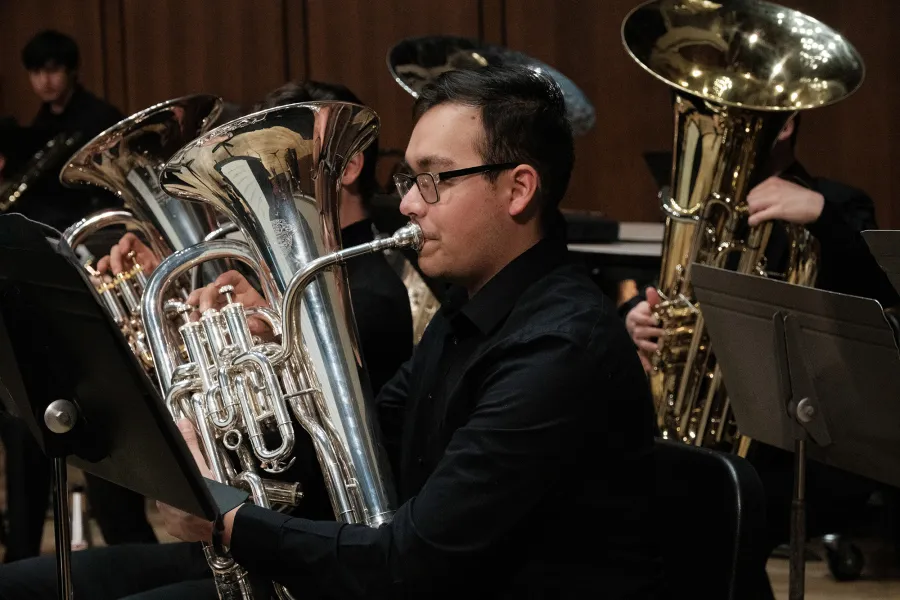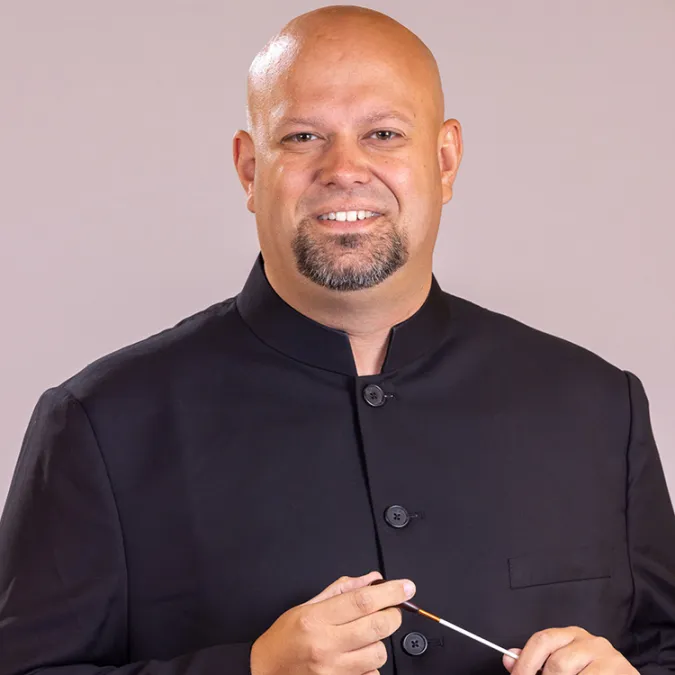
Doug Henderson, conductor
Drew Dickey, guest condcutor
This concert will last approximately 60 minutes with intermission.
Program
Warren Benson
The Passing Bell
Drew Dickey, conductor
Omar Thomas
Forward/Still
Sonia Megías
Metatrón
Short Intermission
Karel Husa
Music for Prague
Introduction and Fanfare
Aria
Interlude
Toccata and Chorale
About the Program
Program Notes by Mark Bilyeu
Warren Bensen
The Passing Bell
BORN January 26, 1924, Detroit, MI
DIED October 6, 2005, Rochester, N.Y
COMPOSED 1974
PREMIERED 1974 Luther College Band, Warren Bensen, guest conductor
DURATION 11 minutes
While an undergraduate student at the University of Michigan, Warren Bensen played timpani under such conductors as Fritz Reiner, Eugene Ormandy, and Leonard Bernstein. A very accomplished percussionist, he was a largely self-taught composer who went on to hold faculty positions in both arenas at institution such as Southern Methodist University, Ithaca College, and finally the Eastman School of Music. A founding member of the World Association for Symphonic Bands and Ensembles, his compositions have been widely recorded by ensembles around the globe. His work The Passing Bell was commissioned by the equally storied Weston Noble at Luther College (Decorah, IA) to honor the memory of Norwegian student and concertmaster Dennis Rathjen who passed away after a brief illness. The work opens with a solo clarinet which reappears throughout the work which centers on two hymn tunes: the Lutheran hymn from Burial Service Jesus, Meine Zuversicht and the Welsh hymn of hope Merthyr Tydvil.
Omar Thomas
Forward/Still
BORN 1984, Brooklyn, N.Y.
COMPOSED 2023
A leader in both jazz and classical styles, composer and arranger Omar Thomas currently serves as Assistant Professor of Composition at The University of Texas at Austin, while his music continues to be heard around the world. “There is an inherent dichotomy built into the title of this work,” writes the composer, “the first word, “forward,” implying motion while the second word, “still,” implies non-motion. Equally dichotomous is the notion that while we move forward in time, there are conflicts, prejudices, tribalist tendencies, and antiquated, non-inclusive ideas that prevent us from truly moving forward — that hold us still. The first half of this work presents a hymn — or a requiem?— that is saturated with weight and burden, reflecting a level of soul weariness that sleep simply cannot fix. Realizing that the only option we have is hope-made-action, the hymn gives way to a soaring effort, seeking to resume the fight towards progress, safety, and collective humanity. The piece eases into an ending with unsettling echoes of the original hymn and a return to the very first chord which should bring comfort and resolution yet leaves us with a feeling of uncertainty. This uncertainty is analogous to our current moment in time — one that humanity has faced at many inflection points throughout our story. If there is any lesson to be gleaned from our cyclical history of struggle and progress, however, it is that regardless how heavy, burdened, and hopeless we feel, we must move forward, still.”
Sonia Megías
Metatrón
BORN 20 June 1982, Almansa, Spain
COMPOSED 2020
PREMIERED September 26th 2020, ADDA Auditorium of Alicante, Spain
DURATION 9 minutes
Sonia Megías identifies as a composer, singer, and multidisciplinary artist. Her scores are often more than simply ink on paper. Her expanded musical notation, which she calls rare sores, go through many iterations that she shows in exhibitions called Mono+Graphics. These works might include video or choreography, they can be tactile, graphic, cartographic, and even edible. She seeks social transformation through playfulness and ritual. She is the recipient of numerous grants and commissions, from the Spanish Ministry of Culture to a Fulbright Grant which funded her graduate work at New York University. She is the founder of the publishing house EdicionesDelantal and the experimental laboratory CoroDelantal which is based in Madrid and the Museum of Contemporary Art of Alicante, where her work Metatrón was premiered. After its premiere, it was chosen as the piece to be projected at the Opening Ceremony of Valencia 2022 World Design Capital in November 2021 at the Queen Sofia Palace for the Arts in Valencia.
Karel Husa
Music for Prague 1968
BORN August 7, 1921, Prague, Czechia
DIED December 14, 2016, Apex, NC
COMPOSED 1968
PREMIERED January 1969, Ithaca College Concert Band, Dr. Kenneth Snapp, conductor
DURATION 22 minutes
In 1968, Czechsclovakia began a slow turn away from Communist ideals and policies, which was denounced by the USSR as the “Prague Spring.” After failed peaceful negotiations, the Soviets invaded Prague on August 20th. Czech composer Karl Husa, vacationing in upstate New York, listened to radio updates about the hostile takeover of his home, and wrote Music for Prague 1968 to honor his native city. His request to have his own program note printed in all performances is honored below:
Three main ideas bind the composition together. The first and most important is an old Hussite war song from the 15th century, Ye Warriors of God and His Law, a symbol of resistance and hope for hundreds of years, whenever fate lay heavy on the Czech nation. It has been utilized also by many Czech composers, including Smetana in My Country. The beginning of this religious song is announced very softly in the first movement by the timpani and concludes in a strong unison (Chorale). The song is never used in its entirety.
The second idea is the sound of bells throughout, Prague, named also the City of “Hundreds of Towers,” has used its magnificently sounding church bells as calls of distress as well as of victory. The last idea is a motif of three chords first appearing very softly under the piccolo solo at the beginning of the piece, in flutes, clarinets and horns. Later it reappears at extremely strong dynamic levels, for example, in the middle of the Aria.
Different techniques of composing as well as orchestrating have been used in Music for Prague 1968 and some new sounds explored, such as the percussion section in the Interlude, the ending of the work, etc. Much symbolism also appears: in addition to the distress calls in the first movement (Fanfares), the unbroken hope of the Hussite song, sound of bells, or the tragedy (Aria), there is also the bird call at the beginning (piccolo solo), a symbol of the liberty which the City of Prague has seen only for moments during its thousand years of existence.
About the Artists

Christopher Drew Dickey
Christopher Drew Dickey serves as Associate Director of the Longhorn Band and as Assistant Director of Bands at the Butler School of Music at The University of Texas at Austin. In addition to his appointment at Texas, Dr. Dickey also serves as the Music Design Coordinator with the Pacific Crest Drum and Bugle Corps in Diamond Bar, California and on the brass instructional staff with The Bluecoats Drum and Bugle Corps in Canton, Ohio. Prior to his current appointments, Dr. Dickey held positions at The South Carolina School of the Arts at Anderson University and Southwood Academy of the Arts, spending a number of years as an educator and administrator in the public schools. He holds the degrees of Doctor of Musical Arts in Wind Conducting from the University of Texas, Master of Music in Music Education from the Ithaca College School of Music, Master of Music in Wind Conducting from Louisiana State University, and Bachelor of Music in Music Education from the University of South Carolina

Douglas Henderson
Douglas Henderson serves as Associate Director of Bands at The University of Texas at Austin, where his responsibilities include conducting the Wind Symphony, teaching advanced undergraduate and graduate conducting, and teaching band literature. Prior to joining the UT faculty, Dr. Henderson was an Associate Professor, Associate Director of Bands, and Director of Athletic Bands at Oklahoma State University. Dr. Henderson is active as a guest conductor, adjudicator, and clinician throughout the United States, and he has guest conducted in Austria and Japan. He is a frequent guest conductor of the World Youth Wind Orchestra Project (WYWOP), in Schladming, Austria. Dr. Henderson received his Bachelor of Music degree in Music Studies from The University of Texas at Austin, his Master of Music degree in Wind Conducting from Michigan State University, and his Doctor of Musical Arts degree in Wind Conducting from The University of Texas at Austin. From 2003-2006, he was the Associate Director of Bands at J.J. Pearce High School in Richardson, Texas.
Wind Symphony
FLUTE
Michelle Cheng
Molly Damitio
Zachary Gray
Kenneth Qu
Ai Ni Wu
Cyrus Yasrebi
Ji Soo Yoon
OBOE
Mary Creel
Lademi Davies
Julia Frank
Zane Laijas
Cristen Patterson
CLARINET
Daniel Aisenberg
Madison Bookman
Jacob Bricker
Brynn Carl
Fiona Condron
Matthew Dombchick
Annabelle Fontanilla
Makenzie James
Katelyn Nguyen
Kyra Rios
Darien Salter
Logan Seaton
Samuel Shin
Mason Smith
Raghav Vemuganti
Alex Vo
Emelie Wu
BASSOON
Wes Booker
Rishabh Sajjan
Daniel Schulze
SAXOPHONE
Joseph Lowry
Catherine Oles
Jacob Otchis
Levi Pena
Inbo Shim
Sam Stricklin
HORN
Alex Allen
Ben Cummings
Grant Koot
Timothy Mccormick
Kaia Santos
TRUMPET
Adam Dimas
Jaime Hernandez
Angelica Salazar
Colby Stone
Alyssa Tuck
Jackson Wolf
TROMBONE
Wyatt Andrews
Arsene Bien-Aime
Wuhyun Jo
Amber Minich
EUPHONIUM
Shelby Burton
Emma Hicks
Nicolas Love
TUBA
Tyler Lane
Riley Mcmahon
Ben Mcwilliams
Nicholas Scruggs
PERCUSSION
Joel Carter
David Hernandez-Espinoza
Ashley Hsu
Gage Lagueux
Luciano Medina
DOUBLE BASS
Reilly Curren
HARP
Alyssa Vought
PIANO
Hsin-Tsu Chang
Event Details
Free Admission

